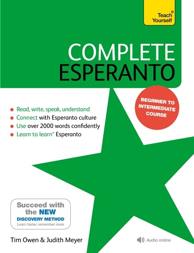 When I started learning Esperanto in 1970, online courses did not exist. To learn a language, you either learnt face-to-face from a teacher or used a book (perhaps with an accompanying vinyl record for pronunciation). Because I had no idea where to find someone who could teach, or even speak, Esperanto, I learnt from a book, specifically Cresswell and Hartley’s Esperanto (2nd edition, 1968), one of the famous Teach Yourself books. The approach was traditional but effective. It taught grammar, but without burdening me with grammatical terminology or too many concepts too early. Other books have followed this basic technique, with varying degrees of success, including Butler’s Step by Step in Esperanto and Stuttard’s The Esperanto Teacher. Other books have used the “direct” technique, where all (or most) of the material is in Esperanto. One such book, which I later used as a textbook in conjunction with lessons at Esperanto House in Sydney in the 1980s, was Szilágyi’s A practical course in Esperanto (1941).
When I started learning Esperanto in 1970, online courses did not exist. To learn a language, you either learnt face-to-face from a teacher or used a book (perhaps with an accompanying vinyl record for pronunciation). Because I had no idea where to find someone who could teach, or even speak, Esperanto, I learnt from a book, specifically Cresswell and Hartley’s Esperanto (2nd edition, 1968), one of the famous Teach Yourself books. The approach was traditional but effective. It taught grammar, but without burdening me with grammatical terminology or too many concepts too early. Other books have followed this basic technique, with varying degrees of success, including Butler’s Step by Step in Esperanto and Stuttard’s The Esperanto Teacher. Other books have used the “direct” technique, where all (or most) of the material is in Esperanto. One such book, which I later used as a textbook in conjunction with lessons at Esperanto House in Sydney in the 1980s, was Szilágyi’s A practical course in Esperanto (1941).
Now a new book has been released, Complete Esperanto by Tim Owen and Judith Meyer. Although published under the “Teach Yourself” banner, it is in no way an updated version of Cresswell and Hartley’s earlier work. In eighteen chapters, plus a grammar summary and basic vocabulary (Esperanto to English and English to Esperanto), it gives the reader the opportunity to go from a complete beginner to someone with intermediate fluency (level B2 of the Common European Frame of Reference for languages).
The book uses what it calls the “Discovery method”, which means that readers are encouraged to discover meanings and patterns by themselves, so that they will retain more of what they have learned. It also has free accompanying audio, which can be listened to online, or offline via the Teach Yourself app.
After Lesson 5 of the original Creswell and Hartley Teach Yourself Esperanto is the following: “Imagine that one fine day you pick up your morning paper and find that it has been completely transformed into Esperanto! Each lesson from now on will use as its basis a typical article taken from this imaginary newspaper…” As attractive as this dream may be, that Esperanto has been adopted as a language for everyday use, Owen and Meyer have taken a different approach. Many of the examples in the book use real Esperanto culture as their context, for example the World Esperanto Congress. In fact, this provides some of the humorous content of the book. For example on page 242 the reader is asked to translate the following sentences (“that might come in handy at your next Esperanto Congress”!) into Esperanto:
a. I don’t like the rhythm and melody of this song.
b. It’s too loud.
c. The guitarist is awful.
d. I would prefer to listen to the other singer.
e. It would be quieter somewhere else.
f. I’d avoid this concert; he sings terribly.
g. Sorry, I misheard because of the noise.
Throughout the book there are many tips about Esperanto culture, many useful expressions and many opportunities to practise and test oneself.
In summary, this would be a very good introduction to Esperanto and Esperantujo for a beginner, and a valuable tool for anyone wanting to consolidate their grasp of the language.
Complete Esperanto
By Tim Owen and Judith Meyer
Published by Teach Yourself (Hodder and Staughton), UK, 2018
ISBN 9781473669185

Kara doktoro
la ISBN 97881473669185, kiun vi donas en via priskribo de la libro (mi mendis gxin en librovendejo en Bern, ne jam ricevis) havas unu ciferon tro. Bonvolu sxangxi la 88 al nur 8.
The ISBN is one digit too long, make 88 to read just 8 and you got it.
Ho, dankon, Ueli. Mi ĵus korektis ĝin.